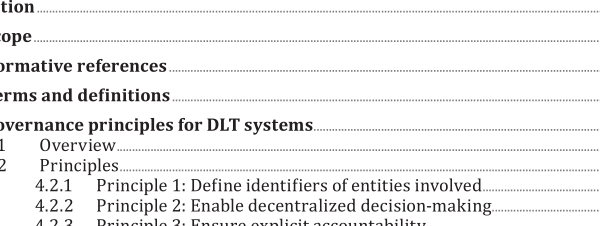ISO TS 23635:2022 pdf download – Blockchain and distributed ledger technologies — Guidelines for governance.
The governance of DLT systems should include commitments to address sustainability issues in their establishment, operation, and termination. NOTE Useful sources of information on sustainability issues are ISO 26000 and UN Sustainable Development Goals (SDGs) [15] . The governance principles provide the foundation for implementing mechanisms, structures, and activities in DLT systems. The statement of each principle refers to why it is important and what should happen, but does not prescribe how, when or by whom the actions must be implemented, as these aspects are dependent on the nature of the DLT systems. 4.2 Principles 4.2.1? Principle? 1:? Define? identifiers? of? entities? involved DLT systems can vary in terms of the identifiers of the actors of the systems. Some DLT systems use pseudonyms as on-ledger identifiers while others use off-ledger identifiers to provide confidence. The definition of identifiers appropriate for the DLT system is the foundation for all governance functions. 4.2.2 Principle 2: Enable decentralized decision-making Decentralization of decision-making is a key characteristic of many DLT systems. Decision-making in DLT systems can either be embedded on-ledger or off-ledger. Decentralized systems foster participation in collective decision-making, thereby enhancing overall trust. DLT systems should enable decentralized, on-ledger decision-making processes. When decisions are made off-ledger, they should be made in an explicit and formal manner. 4.2.3 Principle 3: Ensure explicit accountability Over the lifecycle of DLT systems, ownership and decision-making rights can change and thus, so does accountability. Due to the decentralized nature of most DLT systems, explicit accountability mechanisms are needed to enforce rules. Accountability mechanisms should be enforced on-ledger where appropriate but can be enforced or complemented by off-ledger mechanisms. 4.2.4 Principle 4: Support transparency and openness During a DLT system’s lifecycle, the actions, decisions, and operation of the system should be transparent to DLT stakeholders to enhance trust. DLT systems should comprise mechanisms that allow stakeholders to observe and audit system dynamics. 4.2.5 Principle 5: Align incentive mechanisms with system objectives Incentives in DLT systems drive the achievement of consensus among decision makers, the resolution of conflicts and decisions on the ongoing governance, design, and operation of systems. Incentive mechanisms in DLT systems play a key role in driving desirable behaviour across DLT users and other stakeholder groups. Incentive mechanisms should be explicitly designed to support system objectives. 4.2.6 Principle 6: Provide performance and scalability If performance is not provided, the agility and maintainability of the system is affected. DLT systems should provide mechanisms to meet performance and scalability needs over the lifecycle of the respective DLT system. The use of DLT systems should be effective, efficient, and scalable while achieving system performance. 4.2.7 Principle 7: Make risk-based decisions and address compliance obligations The lifecycle of a DLT system can pose specific risks, including jurisdictional challenges. Challenges should be assessed and treated appropriately in decision-making processes.
ISO TS 23635:2022 pdf download – Blockchain and distributed ledger technologies — Guidelines for governance






